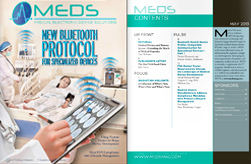Connected Care in Emerging Economies
Health Gateway Helps Doctor Serve More Patients
By Bhaskar Trivedi, Delivery Manager, Samir Bhatt, Technical Lead, and Sunilkumar Singh, Sr. Engineer, elnfochips ltd.
In emerging economies, access to health careservices is limited and expensive. Consider doctor-to-patient ratios: Afghanistan has only 2 doctors for every 10,000 patients, India has 6, China has 18, the United States has 24, and Switzerland has 41 (Source: World Bank, 2010 data). To address this discrepancy, doctors in developing countries need tools to help them prioritize time among patients and deliver care efficiently. Connected care technologies are bridging this gap by giving doctors remote access to patient data. In this article, we present an example proof of concept (PoC) based on the Intel® Quark™ processor. The PoC aggregates patient data and uploads it to the cloud, allowing doctors to analyze patient needs and optimize their schedules accordingly. What’s more, the PoC can be transformed into a low-cost, production- ready design with minimal time and effort – thus creating an effective solution for developing economies.
Download the Full Article Here:
Importance of Computing Health Management in Transportation Systems
The Intelligence Needed to Maximize Long-term Reliability, Manage Costs and Enhance
Customer Satisfaction
The market for transportation systems is forecasted to continue its rapid expansion according to a report by Transparency Market Research that predicts double-digit growth from 2013 to reach $30.2 billion by 2019. As the use of transportation systems expands to monitor, control and provide a diverse set of operator and passenger capabilities, OEMs must integrate more advanced computing technologies to keep up with growing expectations and next-generation requirements. But providing the latest technologies is only part of the requirements list for this critical arena; computing platforms must also enable design fl exibility and deliver long-term availability and value. That is because railway applications are now required to support broad and varied needs from rolling stock and fl eet management to video surveillance, Internet for passengers and ticketing or conductor/driver information. In addition, platform reliability must be at the highest level to ensure maximum uptime availability, safety and security and comply with ISO9001, EN50155 and SIL4 standards and possess IRIS and UNIFE certifi cations.
Download the Full Article Here:
Framework optimize analysis and visualization of medical imaging
Each advancement in medical imaging enables significant improvements in the quality and efficiency of diagnostics and therapy. The challenge: Each advancement requires significant computing performance gains to allow medical image data to be measured and analyzed. And once this massive amount of digital data has been created, it needs to be visualized too – including even stereoscopic 3D in real-time. With CUDA from NVIDIA, OpenCL from Khronos Group and Xeon Phi™ from Intel, several alternative massive parallel processing technologies are available for these tasks – all with their own benefits and restrictions. So which technology is right for data processing on medical backend systems? And how can this technology be combined most efficiently with different processor boards, operating systems and graphic algorithms? This whitepaper helps engineers understand the major differences in technology and identify the most appropriate framework for building their professional, medical-grade image processing systems.
Download the Full Article Here:

